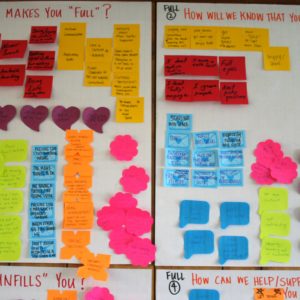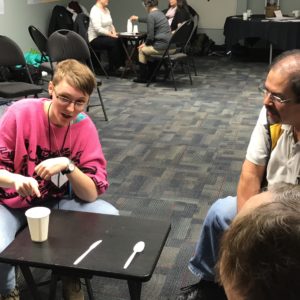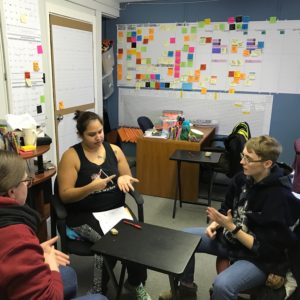Picture this: I grab a beautiful blue egg shell, a white feather, and two model birds, and join my group at a table in the back room for immersion time. Without any discussion or planning, we five young women blow up an imaginary immersion bubble to bid farewell to English – from here on out, we exist only in Unangam Tunuu. Anna is wearing silly prop children’s sunglasses, there’s a hot cup of tea in front of me, and we are all laughing. We are all relaxed.
We start by looking at our table covered in props, this banquet of objects, an abundance of vocabulary. By common consensus, we begin asking each other about the objects. Rachel, what do you have? Mary, what do you have? We are not rushing. We are taking turns. We are listening well. Choices are made about which objects to talk about. While cradling my beautiful egg, I learn the Unangam Tunuu word for it, and for now I forget about the plaster birds.

Helping each other by using hand signs during immersion
When we encounter something that feels new and meaty, we slow down. What’s in the box, you ask? What’s on the box? Oh, that’s new for some of us. At once, the informants slow it down, model the questions and answers, and send them around the table. We learners manage the pace by requesting more repetitions or putting palms down, to say we’ve got it. I make Teresa close her eyes, and set up a joke with Sonia. The thirty minutes pass in a flash, and it’s almost disappointing to pop the immersion bubble and suddenly be reflecting in English.
What makes immersion time easy, though? It’s not always like this. In the past, I have felt abandoned while more fluent speakers carry on without me, awkward about asking them to repeat, or pressured to fake comprehension.
In my opinion, ease in immersion comes from having a community with shared skills and shared purpose. All five of us around the table had a common set of techniques that we were comfortable using. In terms of techniques, we knew how to repeat, slow down, model, adjust our pronunciations, use full sentences, test different answers, and how to request all of these from each other. In terms of purpose, we were all committed to helping ourselves and others improve our fluency. As a result, we were constantly helping each other sound out words, and remember words by showing the associated hand signs. One way of summarizing this is to say that we were constantly making choices to help each other.
If this is my biggest takeaway from Where Are Your Keys, I am happy: It’s possible to relax and learn in immersion. It’s possible to be at ease in another language, knowing how to manage the language itself, and how to work with others to keep developing fluency. The key, of course, is to always be teaching and sharing the techniques, so that you can surround yourself by other skilled language learners and teachers. In other words, we need to populate our immersion tables in order to relax around them.
Post authored by Mary.





